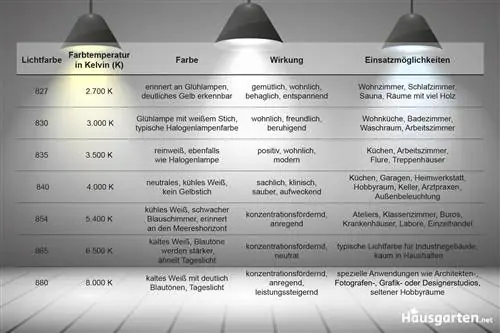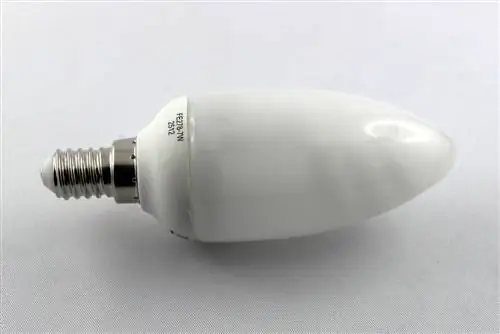- Author admin [email protected].
- Public 2023-12-17 03:39.
- Last modified 2025-01-24 12:45.
If you are looking for a suitable light source for your premises, the right light color is important. In this article you will find the most important information about the individual light colors and color temperatures in Kelvin.
Definition
The term “light color” has two different definitions:
- Color of a light source
- Abbreviation for commercially available bulbs
The first definition refers to the color determined by the color temperature that is produced by self-illuminating objects such as a light bulb. They are given in Kelvin (K) and can be roughly classified into three groups:
- up to 3,300 K: warm white
- 3,300 to 5,300 K: Neutral white
- from 5,300 K: daylight white
The lower the value, the more yellow or orange color stimuli can be seen in the light. The light is “warmer” in terms of color. This effect decreases the higher the color temperature is. It's getting colder". The temperature of the light color has a significant impact on the mood, even though it is all different shades of white. These color temperatures are offered as light colors that are intended to serve as orientation when purchasing.
They are identified by athree-digit code, which, based on example 827, is composed as follows:
- 8: first number of color rendering Ra (80 to 89)
- 27: the following two numbers are the colored temperature (2,700 K)
Note:
In living spaces, the Ra value is always between 80 and 89, which explains the 8 at the beginning of the light color. This value also applies to office and industrial buildings as it is the typical color rendering index for these areas. High-quality lamps with a good Ra value can be found online, for example, at LEDonline.
Light colors: table
Understanding the colors helps to choose the appropriate bulbs. However, the rough division into different levels of white is not always sufficient. Since the individual colors are particularly suitable for different areas of everyday life, the differences between them should be known. This means you can use the right light bulbs to achieve the ideal effect in the rooms. To help you with this, you should take a look at the following table. It presents the common light colors from 827 to 880 in detail:

827
- 2,700 K
- reminiscent of light bulbs, clearly visible yellow
- cozy, homely, comfortable, relaxing
- Living room, bedroom, sauna, rooms with lots of wood
830
- 3,000 K
- Bulb with white cast, typical halogen lamp color
- homely, friendly, calming
- Kitchen-living room, bathroom, laundry room, study room
835
- 3,500 K
- pure white, also like halogen lamp
- positive, homely, modern
- Kitchens, study rooms, hallways, stairwells
840
- 4,000 K
- neutral, cool white, no yellow cast
- factual, clinical, clean, awakening
- Kitchens, garages, home workshops, hobby rooms, basements, doctor's offices, outdoor lighting
854
- 5,400 K
- cool white, faint blue shimmer, reminiscent of the sea horizon
- concentration promoting, stimulating
865
- 6,500 K
- cold white, blue tones become stronger, resembles daylight
- concentration promoting, neutral
- typical light color for industrial buildings, hardly in households
880
- 8,000 K
- cold white with clear blue tones, daylight
- concentration-promoting, stimulating, performance-enhancing
- special applications such as architect, photographer, graphic or designer studios, rarely hobby rooms
Note:
If you are looking for bulbs with different colors, you should try RGB LEDs. With these you can mix your preferred color from around 16,000,000 tones, similar to a color wheel.






